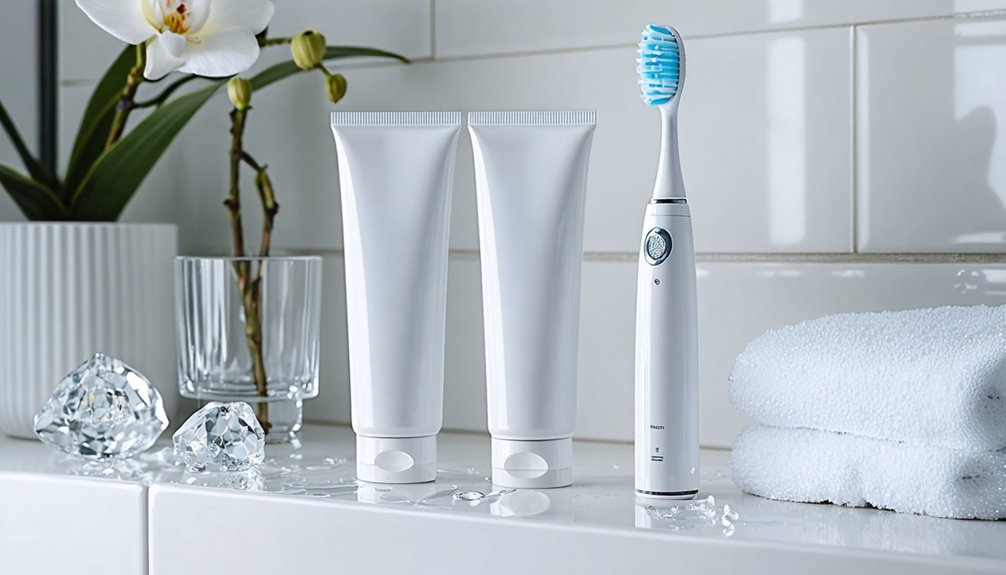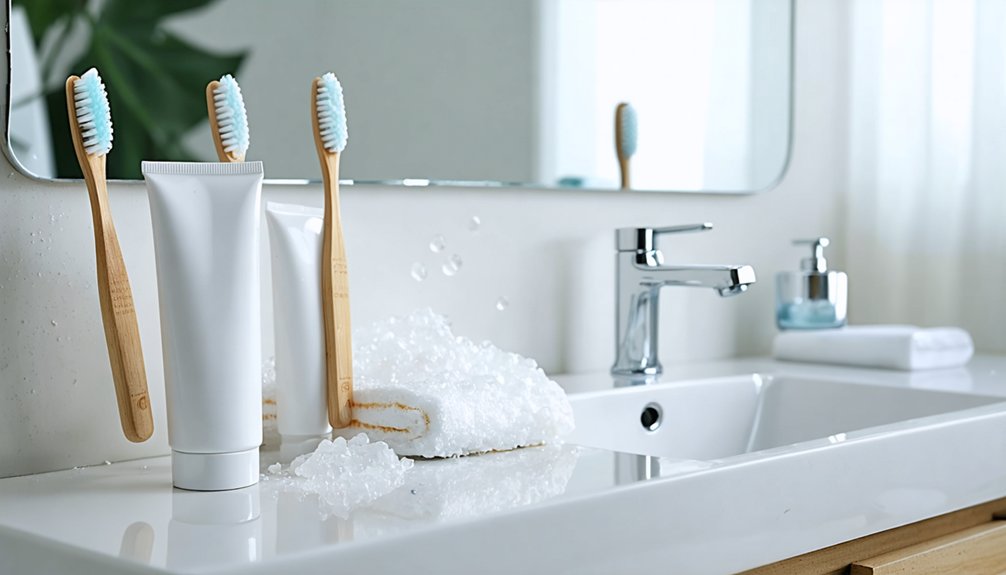You’ll find powerful stain removal in professional-grade options like Colgate Optic White Pro Series (5% hydrogen peroxide) and Crest 3D White Brilliance for overnight results. For sensitive teeth, choose Sensodyne Extra Whitening with potassium nitrate protection. Natural alternatives include activated charcoal formulas or baking soda-based options. Clinical studies show these advanced formulations can eliminate up to 10 years of yellowing within 4 weeks. Understanding the science behind each ingredient helps maximize your whitening results.
Key Takeaways
- Colgate Optic White Pro Series combines 5% hydrogen peroxide with gentle abrasives to remove up to 10 years of yellowing.
- Crest 3D White Brilliance provides visible overnight improvements and achieves 2.6 shade improvements within two weeks.
- Sensodyne Extra Whitening offers both sensitivity protection and stain removal through potassium nitrate and gentle abrasives.
- Opalescence whitening toothpaste uses low-abrasion technology with peroxide for effective stain removal while protecting enamel.
- Natural whitening toothpastes containing baking soda and activated charcoal provide gentle stain removal without harsh chemicals.
Understanding How Whitening Toothpaste Works
When you’re considering whitening toothpaste for discolored teeth, it’s essential to understand how these products work through dual mechanisms.
The primary whitening mechanisms involve physical abrasion and chemical oxidation processes. Abrasive agents like silica and dicalcium phosphate physically remove surface stains, while being gentle enough to protect your enamel. Regular toothpaste brands contain mild abrasives to help with basic stain removal.
The stain chemistry becomes more complex when examining chemical whiteners. Active ingredients such as hydrogen peroxide and carbamide peroxide penetrate your tooth enamel, producing free radicals that break down stain molecules. Professional treatments generally contain higher concentrations of these active ingredients compared to over-the-counter options.
This oxidation process alters how light reflects off your teeth, making them appear whiter. For best results and safety, you’ll want to choose ADA-approved products that balance these mechanisms effectively, ensuring proper stain removal without compromising your dental health.
Top Professional-Grade Whitening Options for Deep Stains
When selecting a professional-grade whitening toothpaste, you’ll find that peroxide-based formulas like Colgate Optic White with 2-5% hydrogen peroxide offer superior deep stain removal compared to standard whitening agents.
For visible improvements, consider Crest 3DWhite Brilliance, which delivers whiter teeth overnight through its revolutionary stain-dissolving formula. Clinical studies show 2.6 shade improvements in just two weeks with consistent use of Crest whitening products.
For ideal results while protecting sensitive teeth, consider low-abrasion options such as Opalescence, which combines effective whitening with enamel-safe technology.
For the most intensive treatment, you’ll want to take into account supplementing your whitening toothpaste with Crest 3D Whitestrips Professional Effects, which can lighten teeth 2-4 shades using 10% hydrogen peroxide.
Peroxide-Based Formulas Comparison
Professional-grade whitening toothpastes containing high concentrations of peroxide offer superior stain removal compared to standard over-the-counter formulations.
When you’re selecting between hydrogen peroxide and carbamide peroxide options, consider that hydrogen peroxide delivers faster whitening through direct oxidation of stains, while carbamide peroxide provides gradual, sustained results.
- Hydrogen peroxide formulations (25-44%) achieve dramatic whitening in 1-2 professional sessions
- Carbamide peroxide breaks down more slowly, extending treatment duration but reducing sensitivity
- Professional application requires protective barriers and specialized protocols for patient safety
- Advanced formulas like Colgate Optic White Pro Series combine 5% hydrogen peroxide with gentle abrasives for ideal peroxide potency and whitening efficacy
Clinical studies demonstrate these professional-grade formulations can eliminate up to 10 years of yellowing within 4 weeks of consistent use. The reactive oxygen molecules break down chromogens in tooth enamel to effectively lighten deep stains. The micro-cleansing formula in products like Crest 3D White Brilliance ensures thorough stain removal while protecting enamel integrity.
Sensitivity-Safe Stain Removal
For patients with sensitive teeth, selecting an effective whitening solution requires careful consideration of both stain-fighting power and protective ingredients.
Professional-grade options now incorporate desensitizing compounds that target sensitivity triggers while delivering noticeable whitening results. At-home kits typically cost between $20 and $100, making them an accessible option for most consumers.
The innovative SNOW Teeth Whitening system combines advanced LED technology with gentle whitening agents for effective stain removal without causing sensitivity. GLO Science kits combine 10% hydrogen peroxide with controlled light and heat technology, minimizing gum exposure and enamel damage. Custom-fit trays in professional kits prevent gel migration, while fluoride-enriched desensitizing serums provide essential enamel protection.
For gentler stain removal, products containing potassium nitrate or stannous fluoride offer gradual whitening with reduced sensitivity risk. Peroxide-free alternatives like PAP-based formulas effectively lift stains without compromising enamel integrity.
When supervised by dental professionals, these sensitivity-safe options can achieve significant whitening while maintaining ideal tooth comfort.
Best Natural and Chemical-Free Whitening Solutions
When seeking chemical-free alternatives for teeth whitening, you’ll find several clinically-supported natural ingredients that can effectively combat discoloration.
Your options include baking soda paste for mild abrasive action, activated charcoal for stain-binding properties, and coconut oil pulling for its antimicrobial benefits. Maintaining proper hydration by drinking water frequently helps preserve whiteness and naturally rinses away staining substances.
Through consistent application of these gentle methods, you can achieve gradual whitening while maintaining the integrity of your tooth enamel. For optimal results, diluted hydrogen peroxide rinses can provide additional whitening effects while naturally fighting bacteria.
Natural Stain-Fighting Ingredients
While chemical whitening agents dominate the market, several natural ingredients have demonstrated clinical efficacy in fighting tooth discoloration.
You’ll find that nature-derived stain fighters can effectively whiten teeth while minimizing risks associated with harsh chemicals. These ingredients work through various mechanisms including enzymatic action, mild acid-based bleaching, and gentle abrasion.
- Papaya enzymes provide natural bleaching properties that break down stains without compromising your enamel integrity.
- Baking soda offers controlled abrasiveness for mechanical stain removal while helping neutralize harmful acids.
- Strawberries contain malic acid and enzymes that work together to lift surface stains naturally.
- Activated charcoal’s adsorption properties can help remove surface discoloration, though it should be used cautiously to protect enamel.
Gentle Whitening Methods
Seeking gentler alternatives to harsh chemical whiteners, many patients can achieve noticeable results through natural whitening methods that protect enamel integrity.
Oil pulling with coconut oil offers antimicrobial benefits while reducing plaque-induced discoloration through daily 15-20 minute treatments. You’ll want to dispose of the oil properly to prevent plumbing complications.
Baking soda provides mild abrasive action when applied as a paste, effectively removing surface stains without significant enamel erosion. For enhanced results, you can combine it with diluted hydrogen peroxide, though this should be done cautiously to prevent sensitivity.
While activated charcoal shows promise for surface stain removal, its long-term safety requires further research. Consider non-toxic organic whitening kits for a balanced approach that combines natural ingredients with proven dental technology.
Eco-Friendly Tooth Care
Eco-conscious consumers now have access to effective natural whitening solutions that minimize environmental impact while promoting oral health.
Today’s eco-friendly toothpaste brands feature biodegradable ingredients like natural abrasives derived from silica sand and plant-based antimicrobial extracts, all housed in sustainable packaging made from recycled materials.
- Natural whitening agents such as coconut oil and baking soda provide gentle stain removal without harsh chemicals.
- Plant-based extracts including neem and aloe vera deliver antimicrobial benefits while freshening breath.
- Formulations exclude synthetic microbeads, SLS, and parabens in favor of coconut-derived surfactants.
- Packaging solutions incorporate biodegradable materials and recyclable components to reduce waste.
While these natural alternatives may require longer-term use for visible results, they offer a safer, environmentally responsible approach to tooth whitening that protects both your smile and the planet.
Sensitive Teeth-Friendly Whitening Formulas

For individuals with sensitive teeth, finding an effective whitening toothpaste requires carefully balanced formulations that won’t trigger discomfort or damage.
You’ll want to look for products containing potassium nitrate, which blocks nerve pain signals, and low-abrasion ingredients like baking soda that gently remove stains without compromising enamel protection.
To avoid common sensitivity triggers, choose SLS-free formulations that prevent gum irritation and dry mouth.
Ingredients like nano hydroxyapatite and fluoride help remineralize your enamel while providing whitening benefits.
Clinical evidence supports that specialized formulas containing these elements can effectively whiten teeth without weakening enamel integrity.
Many dentists recommend products like Sensodyne Extra Whitening, which offers 24-hour sensitivity protection while delivering noticeable whitening results.
Advanced Stain-Fighting Ingredients to Look For
When selecting a whitening toothpaste, understanding the key active ingredients will help you maximize stain removal while protecting your enamel. For ideal stain prevention, look for formulations combining micro-polishers with chemical stain fighters and remineralization agents.
Advanced combinations of stannous fluoride and polyfluorite systems provide extensive enamel protection while targeting discoloration.
- Baking soda-based formulas neutralize harmful acids and penetrate between teeth for deep cleaning.
- Hydrogen peroxide concentrations around 2% safely break down stain molecules for up to 4 shades lighter.
- Stannous fluoride with sodium hexametaphosphate prevents new stains while fighting sensitivity.
- Specialized micro-polishers combined with chemical agents deliver 25x more stain reduction within one week.
Consider products incorporating multiple stain-fighting mechanisms for maximum effectiveness while maintaining strong enamel integrity through regular fluoride remineralization.
Daily Care Tips for Maximum Whitening Results

Achieving ideal whitening results requires a systematic approach to daily oral care that combines proper cleaning techniques with strategic timing and product selection.
You’ll need to brush thoroughly twice daily using proper technique, spending at least two minutes per session. Daily flossing importance can’t be overstated, as it removes stain-causing debris between teeth where brushing can’t reach.
Follow with a whitening or antibacterial mouthwash; benefits include reducing tartar buildup and maintaining brightness between treatments. Time your oral care around staining beverages, using a straw when possible and rinsing with water afterward.
Schedule professional cleanings every six months, and maintain consistent touch-ups as recommended by your dentist. For best results, avoid tobacco products and limit consumption of staining foods and acidic beverages.
Comparing Price Points and Value for Money
Selecting the right whitening toothpaste involves careful consideration of both price and efficacy to maximize your investment in oral care.
Smart toothpaste selection means balancing cost and results to ensure every dollar spent delivers optimal whitening benefits.
Our cost comparison analysis reveals that effective whitening solutions range from $4 to $12, with ingredient effectiveness varying considerably across price points.
- Crest 3D White ($5-$11) offers ideal value with 95% surface stain removal within three days, plus enamel protection.
- Arm & Hammer ($4-$6) provides budget-friendly whitening through baking soda and peroxide formulation.
- Colgate Optic White ($6-$12) delivers professional-grade results with hydrogen peroxide, justified by its deep stain removal.
- Sensodyne Pronamel ($8-$10) combines whitening with sensitivity protection, making it cost-effective for patients with specific oral care needs.
Your selection should align with both your dental concerns and budget constraints, prioritizing formulations that deliver documented clinical results.
Frequently Asked Questions
Can Whitening Toothpaste Damage Existing Dental Work Like Crowns or Veneers?
You’ll want to use caution since whitening ingredients can affect your dental restorations through surface abrasion, potentially altering texture and appearance of crowns or veneers over time.
How Long Should I Wait to Brush After Drinking Coffee or Wine?
Like a shield protecting your castle, you’ll need to wait 30-60 minutes after coffee or wine. Coffee acidity softens enamel, making it vulnerable to enamel erosion during immediate brushing.
Is It Safe to Use Whitening Toothpaste While Pregnant or Nursing?
You can safely use ADA-approved whitening toothpaste while pregnant or nursing, as it contains mild abrasive whitening ingredients rather than strong bleaching agents. Still, consult your healthcare provider for personalized guidance.
Should Whitening Toothpaste Be Used With an Electric or Manual Toothbrush?
You’ll get effective whitening results with either brush type. While electric toothbrush benefits include better plaque removal, studies show manual toothbrush effectiveness combined with whitening toothpaste can achieve superior whitening outcomes.
Can Children Use Whitening Toothpaste, and at What Age Is It Safe?
Over 90% of pediatric dentists advise against whitening before age 12. You shouldn’t let children use whitening toothpaste until their permanent teeth fully emerge and mature, ensuring ideal whitening safety and children’s dental health.
References
- https://mannfamilydental.com/blogs/unlock-your-brightest-smile-the-5-best-whitening-toothpastes-recommended-by-dentists/
- https://myrobstowndentistry.com/choosing-the-best-toothpaste-for-whitening-your-teeth/
- https://nhdentistrybeverlyhills.com/press/the-5-best-whitening-toothpastes-according-to-a-cosmetic-dentist/
- https://www.kirklanddentalexcellence.com/blog/health/best-toothpaste-for-teeth-whitening/
- https://sandlakedental.com/blog/understanding-the-science-behind-teeth-whitening/
- https://enameldentistry.com/how-does-tooth-whitening-toothpaste-work/
- https://www.micasafamilydentistry.com/whitening-toothpaste-time-to-work/
- https://www.luckfamilydental.com/post/how-does-teeth-whitening-toothpaste-work-your-guide-to-the-basics
- https://www.lakebluffdental.com/blog-posts/how-does-tooth-whitening-toothpaste-work-what-you-need-to-know
- https://pmc.ncbi.nlm.nih.gov/articles/PMC4058574/



